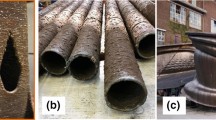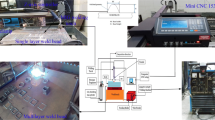Despite the sufficient exploration of industrial methods for the manufacturing of products from metal hafnium, the public domain has a limited number of reports that highlight the technological aspects of hafnium wire manufacturing and their effect on the structure and mechanical properties of the products formed [1, 2]. This article describes the methods employed in the manufacturing of hafnium wire from the ingots of its own production, which have been tested by Chepetsk Mechanical Plant (CMP) under industrial conditions, as well as the advantages and disadvantages of each tested method for producing the wire.
The stages of hafnium wire drawing are described in detail. During the experiments, the relationships between the technological, energy–power parameters, surface quality, and material structure were studied. The effects of the type of drawing tool on the wire surface quality and drawing force were revealed, as well as the effects of the wire diameter on the amount of permissible deformation between the annealed products and the grain size of the metal.
The paper reports the results of studies conducted on the structure, mechanical, and corrosion properties of the experimental samples of wires manufactured in compliance with the ASTM B737 standard specification for hot rolled and/or cold-drawn hafnium rods and wire. Currently, CMP can manufacture wires with a diameter of 1 mm or more from hafnium ingots of its own production, in compliance with the ASTM B737 standard.





Similar content being viewed by others
References
R. V. Azhazha, K. V. Kovtun, A. A. Vasiliev et al., “Research of the structure and properties of hafnium wire,” Metallofizika Noveysh. Tekhn., 35, No. 5, 677–682 (2013).
R. V. Azhazha, S. A. Bespalov, P. Yu. Volosevich et al., “Influence of hot plastic deformation in the range of pre-crystallization temperatures on the structure and hardness of hafnium GFE-1,” VANT. Ser. “Vakuum, Chistyye Materialy, Sverkhprovodniki”, No. 4, 128–132 (2007).
B. Ya. Rozen, Metals of the Atomic Age [in Russian], Publishing house Ukituvchi, Tashkent (1978).
E. Tsegelnik, “Copenhagen in full face and profile. Hafnium,” Atomn. Strateg., No. 22, 32–36 (2006).
A. K. Shikov, O. V. Bocharov, V. M. Arzhakova, V. N. Bezumov, Yu. A. Perlovich, and M. G. Isaenkova, “Creation of Russian hafnium production. Study of properties, structural and textural changes during melting, deformation and heat treatment of hafnium,” Natsionaln. metallurg., No. 6, 77–84 (2002).
I. G. Koparulin, Development and Implementation of Low-Waste Technology for Obtaining High-Purity Hafnium Compounds, PhD Tech. Dissertation abstract, Yekaterinburg (2007).
B. A. Shilyaev, A. L. Ulybkin, K. V. Kovtun et al., “Hafnium in nuclear power industry: the evolution of increasing of the economic indicators and the operation safety of pressurized water nuclear reactors,” PAST, No. 1 (113), 43–50 (2018).
A. L. Ulybkin, A. V. Rybka, K. V. Kovtun et al., “Compton-emissive hafnium detector of neutrons for in-core monitoring,” Yadern. Fiz. Energetik., 19, No. 3, 237–243 (2018).
I. P. Melnikova, Investigation of the Physical Reasons Limiting the Durability and Emissivity of Cathode and Cathode-Grid Knots, and the Possibilities of Improving these Parameters in Microwave Electric Vacuum Devices, PhD (Physics and Mathematics) Dissertation abstract, Saratov State Technical University, Saratov (1997).
Yu. A. Grigoriev, B. S. Pravdin, and V. I. Shesterkin, “Electron-optical systems with grid control,” Obzory Elektron. Tekhn. Elektronika SVCH. Ser. 1. Fryazino, No. 7(1264) (1987).
I. P. Melnikova, A. V. Lyasnikova, and V. N. Lyasnikov, “Dual-use technology: improvement of the functional characteristics of sheet materials used in microwave technology and implantology,” Vestnik SGTU, No. 2 (66), Issue 2, 109–114 (2012).
V. Geanta, I. Voiculescu, and E.-M. Stanciu, “Hafnium influence on the microstructure of FeCrAl alloys,” IOP Conf. Series: Materials Science and Engineering, 133 (2016), 012016; https://doi.org/10.1088/1757-899X/133/1/012016.
I. A. Sheka and K. F. Karlysheva, Hafnium Chemistry, Publishing House “Naukova Dumka”, Kiev (1972).
A. Abdelkareem, “New extraction technique of zirconium and hafnium from zircon mineral,” Arab J. Nucl. Sci Appl., 201–208 (2019).
James V. Jones III, Nadine M. Piatak, and George M. Bedinger, Zirconium and Hafnium. Critical Mineral Resources of the United States — Economic and Environmental Geology and Prospects for Future Supply, Chapter V.U.S. Geological Survey, Reston, Virginia (2017).
James B. Hedrick, Zirconium and Hafnium, U.S. Geological Survey Minerals Yearbook (2001).
D. A. Negodin, M. G. Shtutsa, S. G. Akhtonov et al., “Industrial production of hafnium and products based on it,” VANT, No. 2 (78), 97–101 (2012).
D. A. Negodin, M. G. Shtutsa, E. V. Ilyenko, et al., “Hafnium produced by Chepetsk Mechanical Plant as a material of nuclear energy,” Tsvetn. Metal., No. 1, 59–62 (2014).
D. A. Negodin, D. N. Kharkovsky, and D. V. Dudikhin, “The development of industrial production of foil from hafnium grade GFE-1,” Tsvetn. Metal., No. 3, 92–96 (2020); https://doi.org/10.17580/tsm.2020.03.14.
I. L. Perlin and M. Z. Ermanok, Drawing Theory, Metallurgiya, Moscow (1971).
M. L. Kotsar, S. A. Lavrikov, A. O. Lapidus et al., “Iodide hafnium. Obtaining, composition, properties and application in materials of regulatory units for nuclear reactors,” VANT. Ser. “Fizika radiatsionnykh povrezhdeniy i radiatsionnoye materialovedeniye,” Issue 103, No. 2 (90), 78–84 (2014).
M. L. Kotsar, O. G. Morenko, M. G. Shtutsa, et al., “Obtaining high-purity titanium, zirconium and hafnium by the method of iodide refining under industrial conditions,” Neorganichesk. Material., 46, No. 3, 332–340 (2010).
Ed. D. E. Thomas, E. T. Hayes, and F. M. Perelman, Metallurgy of Hafnium, Metallurgiya, Moscow (1967).
Author information
Authors and Affiliations
Corresponding author
Additional information
Translated from Metallurg, Vol. 64, No. 9, pp. 101–106, September, 2020.
Rights and permissions
About this article
Cite this article
Negodin, D.A., Khar’kovskii, D.N. Development in the Production of Hafnium Wire Conforming to ASTM B737 Standard. Metallurgist 64, 974–983 (2021). https://doi.org/10.1007/s11015-021-01078-0
Received:
Published:
Issue Date:
DOI: https://doi.org/10.1007/s11015-021-01078-0




